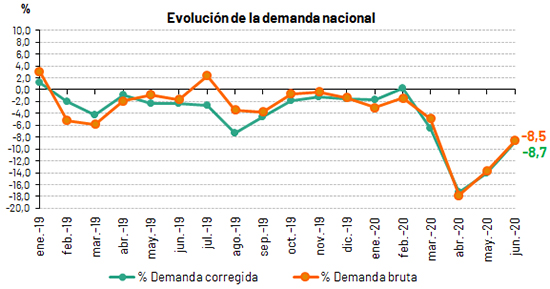Wind energy power represented 17.3%, concentrated solar power 3.9% and photovoltaic 9.2%. Spain’s electricity demand fell 8.5% in June. 43.9% of the monthly generation was from renewable sources and 63.5% were produced from technologies that do not emit CO2 equivalent.
The demand for electrical energy decreased in the Balearic Islands by 33.3% and in the Canary Islands by 14.4% compared to the same month of 2019.
The photovoltaic solar, which produced 92% more than in June 2019, registered a historical maximum of monthly generation nationwide, reaching 1,792 GWh.

Red Eléctrica de España publishes the electricity demand corresponding to June, a month in which the country was still under alarm for 21 days due to Covid-19. In this context, the national electricity demand for June is estimated at 19,442 GWh, 8.5% lower than that registered in the same month of the previous year. If calendar effects and temperatures are taken into account, this figure rises slightly, to 8.7%.
The decrease in June, less pronounced than that of April and May last compared to the same months of 2019, shows a slight recovery in terms of energy consumption. During the alarm period (from March 15 to June 21), demand was 13.3% lower in the Spanish electricity system compared to the same period in 2019.
In the first half of 2020, demand is estimated at 120,340 GWh, 8% less than in 2019. In this case, once the influence of the calendar and temperatures has been corrected, demand is also 8% lower than that registered in the same period of the previous year.
In June and according to today’s estimated data, generation from renewable energy sources represented 43.9% of production. Thus, during the first half of the year, renewable generation reached 46.1% of the national electricity balance.

In this month, 63.5% of electricity production came from technologies that do not emit CO2 equivalent.
With information available today, wind power production in June reached 3,366 GWh, which is 2.4% more than the same period last year, and accounted for 17.3% of national production.
For its part, the photovoltaic solar registered a new monthly generation maximum in June by producing 1,792 GWh, which represents an increase of 92% compared to June 2019. Its contribution to the generation structure, 9.2% over the total, also represents a record of participation.
Demand for electrical energy falls 7.7% in the peninsular electricity system
In the peninsular electricity system, June demand is estimated at 18,437 GWh, 7.7% lower than that registered in the same month of the previous year. If the effects of the calendar and the temperatures are taken into account, the demand is 7.9% lower than that of June 2019.
In the first six months of 2020, the demand for electrical energy in the Peninsula is estimated at 113,989 GWh, 7.7% less than in 2019. In this case, once the influence of calendar and temperatures has been corrected, demand It is also 7.7% lower than that registered in the same period of the previous year.
During this month and according to estimated data today, 45.2% of the peninsular generation was of renewable origin and 65.7% came from technologies that do not emit CO2 equivalent. For its part, wind power registered 3,259 GWh, 1.4% higher than that of June last year, and contributed 17.6% to the mix.
Demand for electrical energy fell 33.3% in the Balearic Islands and 14.4% in the Canary Islands in June
In the Balearic Islands, the demand for electrical energy in June is estimated at 360,001 MWh, 33.3% lower than that registered in the same month of the previous year. If calendar effects and temperatures are taken into account, the figure decreases 32.7% compared to June 2019. In the first half of 2020, Balearic demand is estimated at 2,272,035 MWh, 18.7 % less than in 2019.
The combined cycle, with 72.3% of the total, was the Balearic Islands’ first source of electricity generation, where renewable energies generated in the archipelago and which do not emit CO2 equivalent represented 10.2%. For the sixth consecutive month, coal did not produce any MWh in the Balearic electricity system.
For its part, in the Canary archipelago the electricity demand is estimated at 611,688 MWh, 14.4% lower than that registered in June 2019. If the effects of the calendar and temperatures are taken into account, the figure decreases by 14 , 9% with respect to the same month of the previous year. So far in 2020, demand in the Canary Islands is estimated at 3,884,860 MWh and decreases 9.9% compared to the same period of the previous year.
In June and according to estimated data, the combined cycle was the leading technology in the Canary Islands generation mix, with a contribution of 43.6%. Renewables and emission-free technologies represented 21.3% of Canarian generation.


